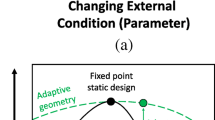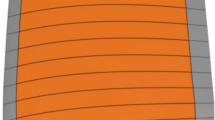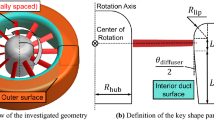Abstract
A promising avenue for development in the aerospace industry involves relocation of engines from conventional locations beneath the wings, to within the aircraft fuselage. Aircraft with these so-called embedded engines have the potential to increase engine efficiency, but necessitate the use of a serpentine engine inlet duct (S-duct) to provide the propulsion system with air. The optimal shape of an aircraft S-duct varies with flight condition, incentivizing the use of morphing systems to vary inlet parameters during flight: allowing for continual supply of the optimal airflow level. Design of a morphing system therefore requires collaboration across multiple disciplines, including aerodynamic analysis and structural analysis. This work presents a methodology for the structural optimization of morphing systems utilizing aerodynamic shape optimization results as inputs, in order to assess the relationship between morphing performance and structural stiffness. The methodology is implemented on a baseline morphing S-duct model for which shape optimization has been previously conducted. Structural optimization is conducted using a gradient-based multi-material topology optimization software with multi-phase penalization. While the conclusions of this work indicate that the impact of multiple material optimization in the S-duct case study is minimal, the methodology does provide non-intuitive designs capable of supporting morphing. At the expense of structural stiffness, the methodology is shown to increase morphing performance through the generation of compliant mechanisms. A parameter study conducted on the S-duct model successfully proves the ability of the methodology to assess the trade-offs between structural and morphing performance. By emphasizing morphing performance, mass reductions from 1.75 kg to 0.201 kg were observed at the expense of a 94% reduction in fatigue lifecycle.
































Similar content being viewed by others
References
Arend DJ, Wolter JD, Hirt SM, Provenza A, Gazzaniga JA, Cousins WT, Hardin LW, Sharma O (2017) Experimental evaluation of an embedded boundary layer ingesting propulsor for highly efficient subsonic cruise aircraft. 53rd AIAA/SAE/ASEE Joint Propul Conf. https://doi.org/10.1121/1.4785127
Bae H, Park S, Kwon J (2013) Efficient global optimization for S-duct diffuser shape design. Proceed Institution Mech Eng, Part G: J Aerospace Eng 227(9):1516–1532. https://doi.org/10.1177/0954410012457891
Case, Bill. 2020. "MYSTRAN general purpose finite element analysis solver." https://www.mystran.com/
Chiereghin N, Guglielmi L, Savill M, Kipouros T, Manca E, Rigobello A, Barison M, Benini E (2017) Shape optimization of a curved duct with free form deformations. 23rd AIAA Comput Fluid Dynam Conf. https://doi.org/10.2514/6.2017-4114
Da Rocha-Schmidt L, Hermanutz A, Baier H, Seitz A, Bijewitz J, Isakveren AT, Scarpa F et al (2014) Progress towards adaptive aircraft engine nacelles. 29th Congress Int Coun Aeron Sci
D'Ambros A, Kipouros T, Zachos P, Savill M, Benini E (2018) Computational design optimization for S-ducts. Designs 2(36). https://doi.org/10.3390/designs2040036
Finch, Thomas E, Enrico Cavatorta, and William Paschal (1992) S-duct for a turbo-jet aircraft engine. United States of America Patent US5299760A. 04 05
Florea V, Pamwar M, Sangha B, Kim IY (2019) 3d multi-material and multi-joint topology optimization with tooling accessibility constraints. Struct Multidiscip Optim. https://doi.org/10.1007/s00158-019-02344-1
Forsgren A, Gill P, Wright M (2002) Interior methods for nonlinear optimization. SIAM J Optimiz 44(4):525–597
Gan W, Zhang X (2017) Design optimization of a three-dimensional diffusing S-duct using a modified SST turbulent model. Aerosp Sci Technol 63:63–72. https://doi.org/10.1016/j.ast.2016.12.016
Gungor O (2017) An approach for optimization of the wall thickness (weight) of a thick-walled cylinder under axially non-uniform internal service pressure distribution. Def Technol 13(3):150–157. https://doi.org/10.1016/j.dt.2017.04.003
Hall CA, Crichton D (2004) Engine and installation configurations for a silent aircraft. J Acoust Soc Am 116(4):2538–2538. https://doi.org/10.1121/1.4785127
Hojjat M, Stavropoulou E, Bletzinger K-U (2014) The vertex morphing method for node-based shape optimization. Comput Methods Appl Mech Eng 268:494–513. https://doi.org/10.1016/j.cma.2013.10.015
Hoyle N, Bressloff NW, Keane AJ (2006) Design optimization of a two-dimensional subsonic engine air intake. Am Inst Aeron Astronautics 44(11):2762–2681. https://doi.org/10.2514/1.16123
Icardi U, Ferrero L (2009) Preliminary study of an adaptive wing with shape memory alloy torsion actuators. Mater Des 30(10):4200–4210. https://doi.org/10.1016/j.matdes.2009.04.045
Ion A, Frohnhofen J, Wall L, Kovacs R, Alistar M, Lindsay J, Lopes P, Chen H-T, Baudisch P (2016) Metamaterial mechanisms. UIST: Proceed 29th Ann Symp User Interface Software Techn:529–539. https://doi.org/10.1145/2984511.2984540
Iwaniuk A, Wisnoiwski W, Zoltak J (2016) Multi-disciplinary optimisation approach for a light turboprop aircraft-engine integration and improvement. Aircr Eng Aerosp Technol 88(2):348–355. https://doi.org/10.1108/AEAT-02-2015-0070
Kamat V, Rao V, Xu M, Saxena S (2020) Flow distortion based S-duct optimization using adjoint methdology. AIAA Aviation 2020 Forum. https://doi.org/10.2514/6.2020-2755
Kashanian K, Shah V, Pamwar M, Sangha B, Kim IY (2020) Motorcycle chassis design utilizing multi-material topology optimization. SAE Techn Paper:01–0509. https://doi.org/10.4271/2020-01-0509
Kim HD, Felder JL, Tong MT, Berton JJ, Haller WJ (2014) Turboelectric distributed propulsion benefits on the N3-X vehicle. Aircr Eng Aerosp Technol 86(6):558–561. https://doi.org/10.1108/AEAT-04-2014-0037
Lee BJ, Kim C, Rho OH (2003) Aerodynamic optimization for the subsonic s-shaped diffuser using two-equation turbulence models. 16th AIAA Computat Fluid Dynam Conf. https://doi.org/10.2514/1.16123
Lefantzi, Sophia, and Doyle D Knight. 2002. "Automated design optimization of a three-dimensional s-shaped subsonic diffuser." J Propuls Power 18 (4): 913. https://doi.org/10.2514/2.6017
Li C, Kim IY (2017) Multi-material topology optimization for automotive design problems. Inst Mech Eng Part D: J Automotive Eng:1–20. https://doi.org/10.1177/0954407017737901
Li C, Kim IY (2015) Topology, size and shape optimization of an automotive cross car beam. J Automobile Eng 229(10):1361–1378
Li C, Kim IY, Jeswiet J (2015) Conceptual and detailed design of an automotive engine cradle by using topology, shape, and size optimization. Struc Multidiscplin Optim 51(2):547–564
Li D, Kim IY (2019) Modified element stacking method for multi-material topology optimization with anisotropic materials. Struct Multidiscip Optim 61:525–541
Li D, Kim IY (2018) Multi-material topology optimization for practical lightweight design. Struct Multidiscip Optim 58(3):1081–1094
Li D, Roper S, Woischwill C, Carrick C, Kim IY (2017) Multi-material lightweight design by topology optimization. Proceed 26th CANCAM
Li Z-M, Yu J, Yu Y, Lixin X (2018) Topology optimization of pressure structures based on regional contour tracking technology. Struct Multidiscip Optim 58(2). https://doi.org/10.1007/s00158-018-1923-5
Lu K-J, Kota S (2003) Design of compliant mechanisms for morphing structural shapes. J Intell Mater Syst Struct 14(6):379–391. https://doi.org/10.1177/1045389X03035563
Majic F, Efraimsson G, O'Reilly C (2016) Potential improvement of aerodynamic performance by morphing the nacelle inlet. Aerosp Sci Technol 54:122–131. https://doi.org/10.1016/j.ast.2016.04.006
Marchlewski K, Laniewski-Wollk L, Kubacki S (2020) Aerodynamic shape optimization of a gas turbine engine air-delivery duct. J Aerosp Eng 33(4). https://doi.org/10.1061/(ASCE)AS.1943-5525.0001157
Molinari G, Quack M, Dmitriev V, Morari M, Jenny P, Ermanni P (2011) Aero-structural optimization of morphing airfoils for adaptive wings. J Intell Mater Syst Struct 22(10):1075–1089. https://doi.org/10.1177/1045389X11414089
Molinari G, Arrieta AF, Ermanni P (2014) Aero-structural optimization of three-dimensional wings with embedded smart actuators. Am Inst Aeron Astronautics 52(9):1940–1951. https://doi.org/10.2514/1.J052715
Nam J, Patil S (2019) Duct shape optimization using multi-objective and geometrically constrained adjsoint solver. SAE Techn Paper 0823. https://doi.org/10.4271/2019-01-0823
Ng YT, Luo SC, Lim TT, Ho QW (2011) Three techniques to control flow separation in an S-shaped duct. Am Inst Aeron Astronautics 49(9):1825–1832. https://doi.org/10.2514/1.J050135
Patton ST, Chen C, Hu J, Grazulis L, Schrand AM, Roy AK (2016) Characterization of thermoplastic polyurethane (TPU) and Ag-carbon black TPU nanocomposite for potential application in additive manufacturing. MDPI Polymers 9(6):1–17. https://doi.org/10.3390/polym9010006
Prusa J (2020) Prusa Multi-Material Upgrade 2S for MK3S and MK2.5S 3D printers. Prusa Research A.S. Accessed 07 09, 2020. https://www.prusa3d.com/original-prusa-i3-multi-material-2-0/
Puigoriol-Forcada JM, Alsina A, Salazar-Martin AG, Gomez-Gras G, Perez MA (2018) Flexural fatigue properties of polycarbonate fused-deposition modelling specimens. Mater Des 155:414–421. https://doi.org/10.1016/j.matdes.2018.06.018
Roper S, Li D, Florea V, Woischwill C, Kim IY (2018) Multi-material topology optimization: a practical approach and application. SAE Techn Paper:01–0110. https://doi.org/10.4271/2018-01-0110
Ryan L, Kim IY (2019) A multiobjective topology optimization approach for cost and time minimization in additive manufacturing. Int J Num Methods Eng 118(7):371–394
Safari, Lauren, Juan Sebastian Cuellar, Gerwin Smit, and Amir A Zadpoor. 2019. "A review of the fatigue behaviour of 3D printed polymers." Additive Manuf 28: 87–97. https://doi.org/10.1016/j.addma.2019.03.023
Shah V, Kashanian K, Pamwar M, Sangha B, Kim IY (2020) Multi-material topology optimization considering manufacturing constraints. SAE Techn Paper:01–0628. https://doi.org/10.4271/2020-01-0628
Shevtsov S, Zhilyaev I, Oganesyan P, Axenov V (2017) Optimization of wall thickness and lay-up for the shell-like composite structure loaded by non-uniform pressure field. AIP Conf Proceed 1798(1). https://doi.org/10.1063/1.4972736
Sigmund O, Clausen PM (2007) Topology optimization using a mixed formulation: an alternative way to solve pressure load problems. Comput Methods Appl Mech Eng 196(13–16):1874–1889. https://doi.org/10.1016/j.cma.2006.09.021
Sokolowski J, Zolesio JP (1992) Introduction to shape optimization, vol 16. Springer, Berlin, Heidelberg
Stratasys Ltd (2020) PC (polycarbonate) FDM thermoplastic filament material data sheet. accessed 07 28, 2020. https://www.stratasys.com/materials/search
Stratasys Ltd. 2018. "FDM TPU 92A material data sheet." Accessed Nov 20, 2019. https://www.stratasys.com/materials/search/fdm-tpu-92a
Tits A, Wachter A, Bakhtiari S, Urban T, Lawrence C (2003) A primal-dual interior-point method for nonlinear programming with strong global and local convergence properties. SIAM J Optim 14(1):173–199
Uranga A, Drela M, Greitzer EM, Neil A, Titchener ML, Siu NM, Huang AC, Gatlin GM, Hannon JA (2014) Preliminary experimental assessment of the boundary layer ingestion benefit for the D8 Aircraft. AIAA SciTech 52:1–25. https://doi.org/10.2514/6.2014-0906
Vierhout G, Roper S, Li D, Pamwar M, Sangha B, Kim IY (2019) Multi-material topology optimization as a concept generation and design tool. SAE Techn Paper:01–1095. https://doi.org/10.4271/2019-01-1095
Woischwill C, Kim IY (2018) Multimaterial multijoint topology optimization. Int J Num Methods Eng:1–28
Zhou M, Shyy YK, Thomas HL (2001) Checkerboard and minimum member size control in topology optimization. Struct Multidiscip Optim 21(2):152–158
Acknowledgements
The authors would like to thank David Zingg and David Koo at the University of Toronto Institute of Aerospace Studies for their aerodynamic shape optimization analysis, and Hani Naguib, Jamie Lee, and Ryan Nam at the Smart Polymers and Composites Lab for their research on shape memory alloys.
Funding
This research was funded by the Natural Research Council of Canada (NRC).
Author information
Authors and Affiliations
Corresponding author
Ethics declarations
Conflict of interest
The authors declare that they have no conflict of interest.
Replication of results
Python 3.7 source code is included below to assist in replication of results:



Additional information
Responsible Editor: Ji-Hong Zhu
Publisher’s note
Springer Nature remains neutral with regard to jurisdictional claims in published maps and institutional affiliations.
Rights and permissions
About this article
Cite this article
Munroe, E., Bohrer, R., Chishty, W.A. et al. Structural design of a morphing serpentine inlet using a multi-material topology optimization methodology. Struct Multidisc Optim 64, 389–422 (2021). https://doi.org/10.1007/s00158-021-02885-4
Received:
Revised:
Accepted:
Published:
Issue Date:
DOI: https://doi.org/10.1007/s00158-021-02885-4




